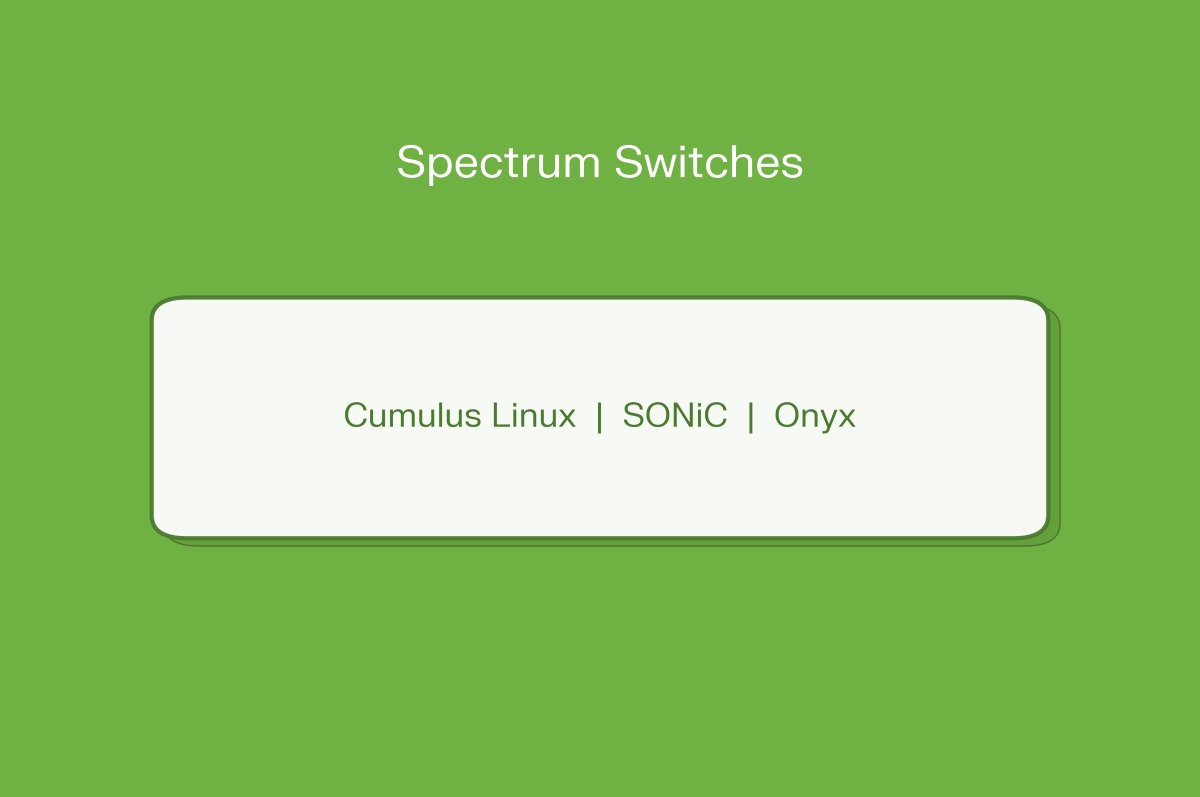Hey there, network engineer, architect, or even curious enthusiast — welcome to the ever-evolving world of network operating systems (NOS)! If you’ve landed here, chances are you’re exploring your options for deploying a NVIDIA Spectrum switch, or maybe you’re already running one and wondering which NOS best fits your environment.
And you’re right to wonder. These switches are incredible. From powering AI workloads and HPC fabrics to supporting cloud-scale data centers, NVIDIA Spectrum switches are among the most advanced Ethernet switching platforms available today. But hardware alone doesn’t define performance. Your network operating system (NOS) is the brain behind the brawn.
Now here’s where it gets interesting: NVIDIA offers not one but three different NOS options. Each is uniquely powerful, and more importantly, each is designed for different types of users and operational models. So choosing between Onyx, Cumulus Linux, and SONiC isn’t about which is “better” — it’s about which is better for you.
- Maybe you’re an automation-driven team with a love for Ansible and Linux scripting.
- Or perhaps you’re all about open-source ecosystems and containerized control planes.
- Or maybe you’re in an HPC or RoCE-sensitive environment where deterministic performance is key.
No matter where you fall, this article is here to help you make sense of it all. We’ll break down each NOS in simple terms, give you a comparison chart you can actually use, show you which NVIDIA switches support which NOS, and most importantly: we’ll help you pick the right one based on your use case, team skill set, and goals.
Let’s dive in!
NOS Comparison: Onyx vs SONiC vs Cumulus Linux
| Feature | Onyx | Cumulus Linux | SONiC |
| Origin | Mellanox (now NVIDIA) | Cumulus Networks (acquired by NVIDIA) | Microsoft (open source) |
| Base Architecture | Proprietary CLI, Linux kernel underneath | Debian Linux + FRR + native Linux tools | Modular, container-based, JSON configuration |
| User Experience | CLI-driven, legacy-like | Linux-native; ideal for NetDevOps workflows | Abstracted; great for hyperscalers |
| Protocol Support | Full Layer 2/3, BGP, MLAG, RoCE, telemetry | Full Layer 2/3, FRR for BGP/OSPF/IS-IS, VXLAN | BGP, EVPN, VLANs, VXLAN via SAI abstraction |
| Automation Compatibility | Moderate; scripting via CLI/API | Excellent; Ansible, Puppet, REST, systemd | Strong; container APIs, open community modules |
| Open Source | No | Yes (some components) | Fully open source |
| Customizability | Limited | Full Linux shell access | Requires JSON/db configuration interaction |
| Ideal For | HPC, RoCE, AI training, legacy CLI operators | Data center ops, automation teams, DevNetOps | Hyperscale DCs, multi-vendor abstraction |
| Vendor Lock-in | High | Low | Low |
Supported NVIDIA Spectrum Switches for Each NOS
Let’s make this super clear: most NVIDIA Spectrum switches support all three NOS platforms. However, your experience will vary depending on your NOS of choice. Here’s a breakdown:
| Switch Model | Onyx | Cumulus Linux | SONiC |
| Spectrum-1 (e.g. SN2700) | Yes | Yes | Yes |
| Spectrum-2 (e.g. SN3700) | Yes | Yes | Yes |
| Spectrum-3 (e.g. SN4700) | Yes | Yes | Yes |
| Spectrum-4 (e.g. SN5600) | Limited | Recommended | Recommended |
| Open networking switches (ONIE) | No | Yes | Yes |
Note: Onyx is gradually being phased out for Spectrum-4 and newer deployments. NVIDIA recommends using Cumulus or SONiC for newer generation switches.
When to Use Which NOS?
So here you are, standing at the crossroads of NOS nirvana. You’ve got three solid options, and each has its charm. Let me help you figure it out by summarizing like a friend would:
Use Onyx if:
- You need ultra-low latency and precision (e.g., financial trading, RDMA, RoCEv2)
- You’re comfortable with CLI and don’t plan to deeply automate
- You’re working on Spectrum-1/2/3 platforms and want something rock-stable
Use Cumulus Linux if:
- Your team is Linux-savvy and uses Ansible, Chef, NetBox, or GitOps
- You want full flexibility, full Linux, and are ready to embrace NetDevOps
- You love having the shell access and writing bash scripts to solve problems
Use SONiC if:
- You’re building hyperscale cloud or DC fabric
- You value vendor neutrality and containerized architecture
- You want to tap into the latest open networking innovations
There’s no wrong answer here. NVIDIA’s real power lies in giving you choices — and that’s something few vendors can say. Whether you go full DevOps with Cumulus, ride the open-source wave with SONiC, or keep things simple and tight with Onyx, you’re working with world-class networking foundations.
